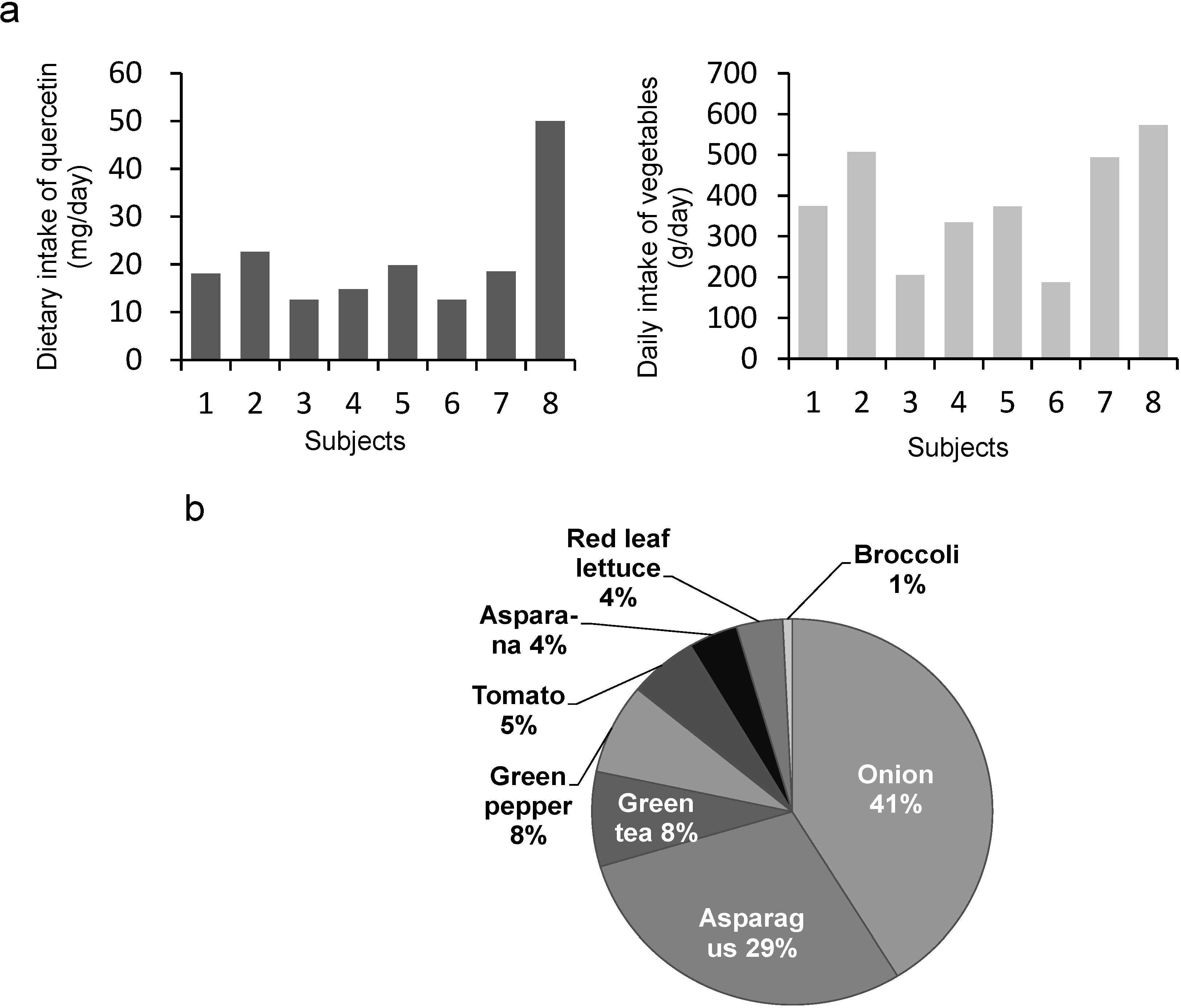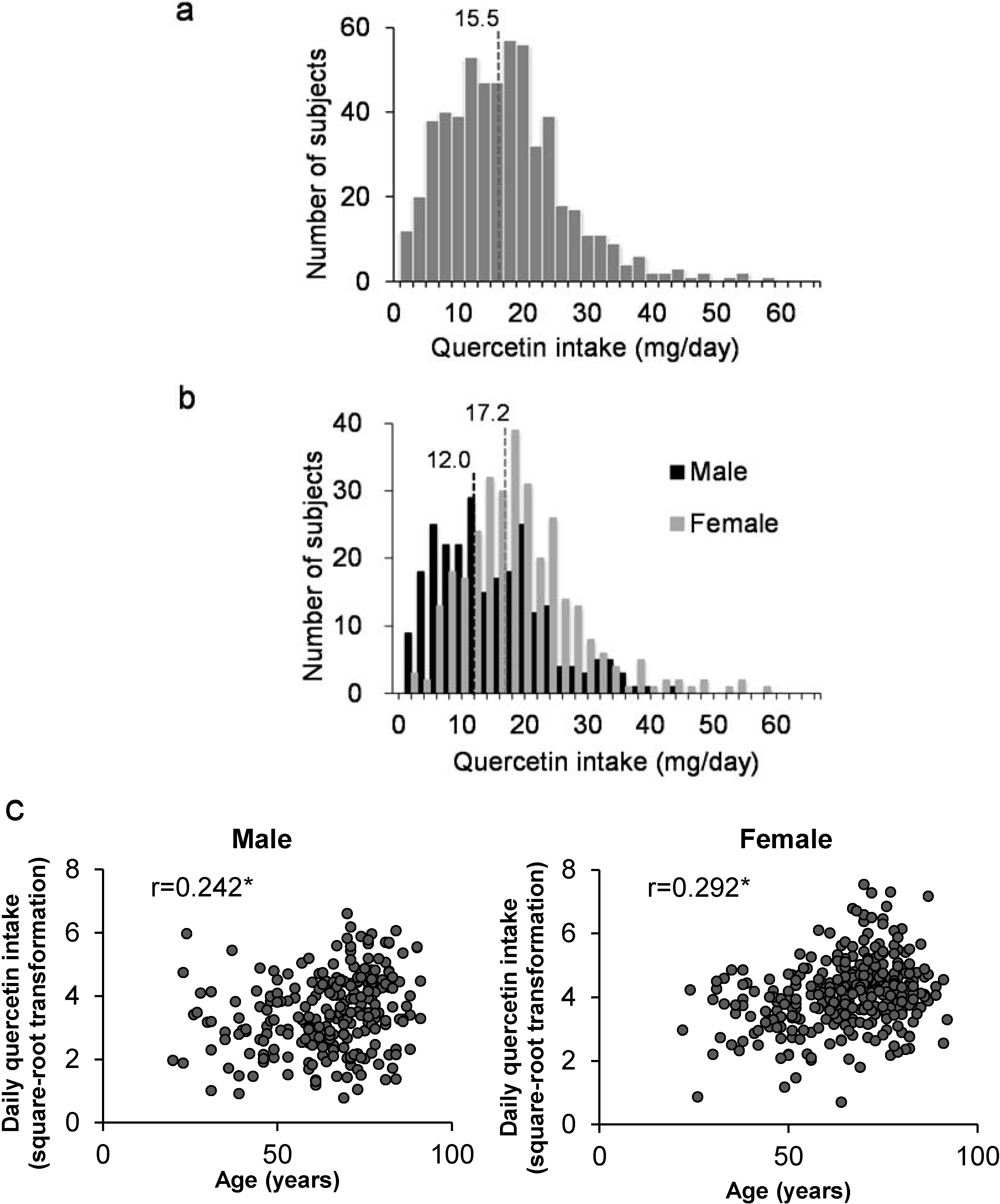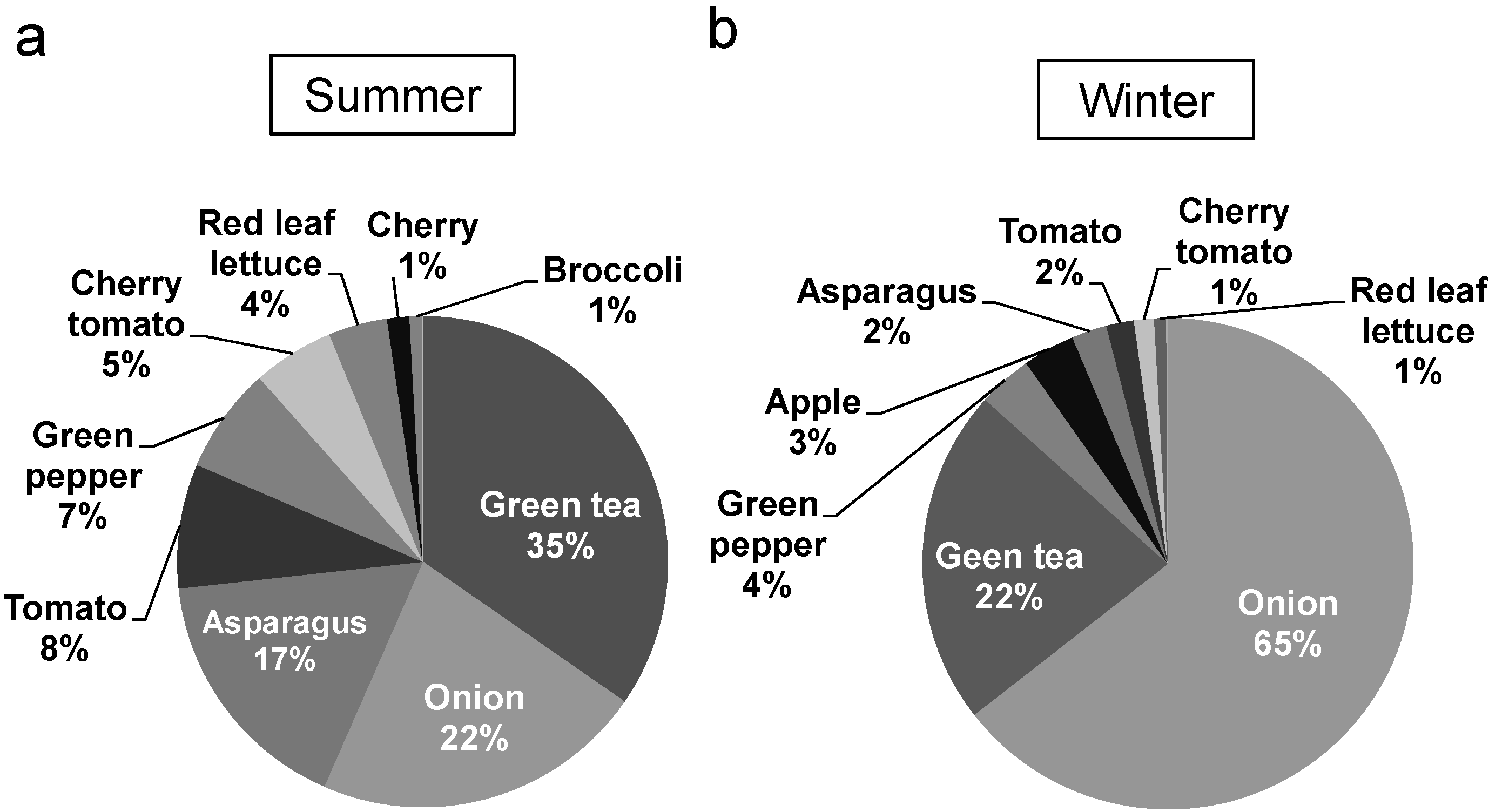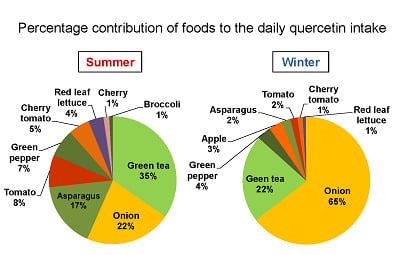Estimated Daily Intake and Seasonal Food Sources of Quercetin in Japan
Abstract
:1. Introduction
2. Experimental Section
2.1. Materials
2.2. Determination of Quercetin Content
2.3. Diet Survey
| Acquisition period | Food | Quercetin content |
|---|---|---|
| (mg 100 g−1 FW or mg (100 mL)−1 *) | ||
| June–July 2013 | Red leaf lettuce (Lactuca sativa L. var. crispa) | 30.6 |
| Asparagus (Asparagus officinalis L.) | 23.6 | |
| Romaine lettuce (Lactuca sativa L. var. longifolia) | 12.0 | |
| Onion (Allium cepa L.) | 11.0 | |
| Green pepper (Capscicum annuum L.) | 9.9 | |
| Asupara-na (Brassica rapa) | 4.3 | |
| Cherry tomato (Solanum lycopersicum) | 3.3 | |
| Podded pea (Pisum sativu L.) | 1.7 | |
| Tomato (Solanum lycopersicum) | 1.6 | |
| Broccoli (Brassica oleracea var. italica) | 1.6 | |
| Cherry (Prunus avium L.) | 1.2 | |
| Green tea infusion | 2.1* | |
| Welsh onion (Allium fistulosum L.) | N.D. | |
| Spinach (Spinacia oleracea L.) | N.D. | |
| Potato (Solanum tuberosum L.) | N.D. | |
| Red shiso1 (Perilla frutescent var. crispa) | N.D. | |
| Green shiso2 (Perilla frutescent var. crispa) | N.D. | |
| Eggplant (Solanum melongena L.) | N.D. | |
| Cabbage (Brassica oleracea L. var. capitata) | N.D. | |
| Dried buckwheat nudles (boiled) | N.D. | |
| December 2013 | Onion (Allium cepa L.) | 41.9 |
| Red leaf lettuce (Lactuca sativa L. var. crispa) | 10.3 | |
| Apple (Fuji) (Malus domestica Borkh.) | 2.3 | |
| Broccoli (Brassica oleracea var. italica) | 0.5 | |
| Spinach (Spinacia oleracea L.) | N.D. | |
| Garland chrysanthemum (Glebionis coronaria) | N.D. | |
| Chinese cabbage (Brassica rapa var. pekinensis) | N.D. |
2.4. Statistical Analysis
3. Results
3.1. Estimated Dietary Quercetin Intakes by Female Volunteers Using Two-Day Weighted Food Record

3.2. Estimated Daily Quercetin Intakes of Residents by FFQ




4. Discussion
5. Conclusions
Acknowledgments
Author Contributions
Conflicts of Interest
References
- Formica, J.V.; Regelson, W. Review of the biology of quercetin and related bioflavonoids. Food Chem. Toxicol. 1995, 33, 1061–1080. [Google Scholar] [CrossRef] [PubMed]
- Knekt, P.; Jarvinen, R.; Reunanen, A.; Maatela, J. Flavonoid intake and coronary mortality in Finland: A cohort study. BMJ 1996, 312, 478–481. [Google Scholar] [CrossRef] [PubMed]
- Arts, I.C.W.; Hollman, P.C.H. Polyphenols and disease risk in epidemiologic studies. Am. J. Clin. Nutr. 2005, 81, 317s–325s. [Google Scholar] [PubMed]
- Hollman, P.C.H.; Katan, M.B. Dietary flavonoids: Intake, health effects and bioavailability. Food Chem. Toxicol. 1999, 37, 937–942. [Google Scholar] [CrossRef] [PubMed]
- Hooper, L.; Kroon, P.A.; Rimm, E.B.; Cohn, J.S.; Harvey, I.; Le Cornu, K.A.; Ryder, J.J.; Hall, W.L.; Cassidy, A. Flavonoids, flavonoid-rich foods, and cardiovascular risk: A meta-analysis of randomized controlled trials. Am. J. Clin. Nutr. 2008, 88, 38–50. [Google Scholar] [PubMed]
- Kelly, G.S. Quercetin. Monograph. Altern. Med. Rev. 2011, 16, 172–194. [Google Scholar] [PubMed]
- Peterson, J.J.; Dwyer, J.T.; Jacques, P.F.; McCullough, M.L. Associations between flavonoids and cardiovascular disease incidence or mortality in European and US populations. Nutr. Rev. 2012, 70, 491–508. [Google Scholar] [CrossRef] [PubMed]
- Terao, J.; Kawai, Y.; Murota, K. Vegetable flavonoids and cardiovascular disease. Asia Pac. J. Clin. Nutr. 2008, 17, 291–293. [Google Scholar] [PubMed]
- Morales, J.; Gunther, G.; Zanocco, A.L.; Lemp, E. Singlet oxygen reactions with flavonoids. A theoretical-experimental study. PLoS ONE 2012, 7, e40548. [Google Scholar] [CrossRef] [PubMed]
- Lagoa, R.; Graziani, I.; Lopez-Sanchez, C.; Garcia-Martinez, V.; Gutierrez-Merino, C. Complex I and cytochrome c are molecular targets of flavonoids that inhibit hydrogen peroxide production by mitochondria. Biochim. Biophys. Acta 2011, 1807, 1562–1572. [Google Scholar] [CrossRef] [PubMed]
- Mahesh, T.; Menon, V.P. Quercetin allievates oxidative stress in streptozotocin-induced diabetic rats. Phytother. Res. 2004, 18, 123–127. [Google Scholar] [CrossRef] [PubMed]
- Boesch-Saadatmandi, C.; Wagner, A.E.; Wolffram, S.; Rimbach, G. Effect of quercetin on inflammatory gene expression in mice liver in vivo—Role of redox factor 1, miRNA-122 and miRNA-125b. Pharmacol. Res. 2012, 65, 523–530. [Google Scholar] [CrossRef] [PubMed]
- Kobori, M.; Masumoto, S.; Akimoto, Y.; Takahashi, Y. Dietary quercetin alleviates diabetic symptoms and reduces streptozotocin-induced disturbance of hepatic gene expression in mice. Mol. Nutr. Food Res. 2009, 53, 859–868. [Google Scholar] [CrossRef] [PubMed]
- Kobori, M.; Masumoto, S.; Akimoto, Y.; Oike, H. Chronic dietary intake of quercetin alleviates hepatic fat accumulation associated with consumption of a Western-style diet in C57/BL6J mice. Mol. Nutr. Food Res. 2011, 55, 530–540. [Google Scholar] [CrossRef] [PubMed]
- Dong, J.; Zhang, X.; Zhang, L.; Bian, H.; Xu, N.; Bao, B.; Liu, J. Quercetin reduces obesity-associated ATM inflammation in mice: A mechanism including AMPKα1/SIRT1. J. Lipid Res. 2014, 55, 363–374. [Google Scholar] [CrossRef] [PubMed]
- Murota, K.; Hotta, A.; Ido, H.; Kawai, Y.; Moon, J.H.; Sekido, K.; Hayashi, H.; Inakuma, T.; Terao, J. Antioxidant capacity of albumin-bound quercetin metabolites after onion consumption in humans. J. Med. Investig. 2007, 54, 370–374. [Google Scholar] [CrossRef]
- Ishisaka, A.; Kawabata, K.; Miki, S.; Shiba, Y.; Minekawa, S.; Nishikawa, T.; Mukai, R.; Terao, J.; Kawai, Y. Mitochondrial dysfunction leads to deconjugation of quercetin glucuronides in inflammatory macrophages. PLoS ONE 2013, 8, e80843. [Google Scholar] [CrossRef] [PubMed]
- Zamora-Ros, R.; Knaze, V.; Lujan-Barroso, L.; Slimani, N.; Romieu, I.; Fedirko, V.; de Magistris, M.S.; Ericson, U.; Amiano, P.; Trichopoulou, A.; et al. Estimated dietary intakes of flavonols, flavanones and flavones in the European Prospective Investigation into Cancer and Nutrition (EPIC) 24 hour dietary recall cohort. Br. J. Nutr. 2011, 106, 1915–1925. [Google Scholar] [CrossRef] [PubMed]
- Ioku, K.; Aoyama, Y.; Tokuno, A.; Terao, J.; Nakatani, N.; Takei, Y. Various cooking methods and the flavonoid content in onion. J. Nutr. Sci. Vitaminol. 2001, 47, 78–83. [Google Scholar] [CrossRef] [PubMed]
- Ohnishi, H.; Saitohi, S.; Takagii, S.; Katohi, N.; Chibai, Y.; Akasakai, H.; Nakamura, Y.; Shimamoto, K. Incidence of type 2 diabetes in individuals with central obesity in a rural Japanese population: The Tanno and Sobetssu study. Diabetes Care 2006, 29, 1128–1129. [Google Scholar] [CrossRef] [PubMed]
- Mitsumata, K.; Saitoh, S.; Ohnishi, H.; Akasaka, H.; Miura, T. Effects of parental hypertension on longitudinal trends in blood pressure and plasma metabolic profile: Mixed-effects model analysis. Hypertension 2012, 60, 1124–1130. [Google Scholar] [CrossRef] [PubMed]
- Slimestad, R.; Fossen, T.; Vagen, I.M. Onions: A source of unique dietary flavonoids. J. Agric. Food Chem. 2007, 55, 10067–10080. [Google Scholar] [CrossRef] [PubMed]
- Jin, J.; Koroleva, O.A.; Gibson, T.; Swanston, J.; Magan, J.; Zhang, Y.; Rowland, I.R.; Wagstaff, C. Analysis of phytochemical composition and chemoprotective capacity of rocket (Eruca sativa and Diplotaxis tenuifolia) leafy salad following cultivation in different environments. J. Agric. Food Chem. 2009, 57, 5227–52234. [Google Scholar] [CrossRef] [PubMed]
- Watanabe, J.; Takebayashi, J.; Takano-Ishikawa, Y.; Yasui, A. Evaluation of a Method to Quantify Quercetin Aglycone in Onion (Allium cepa) by Single- and Multi-laboratory Validation Studies. Anal. Sci. 2012, 28, 1179–1182. [Google Scholar] [CrossRef] [PubMed]
- Okamoto, D.; Noguchi, Y.; Muro, T.; Morishita, M. Genetic variation of quercetin glucoside content in onion (Allium cepa L.). J. Jpn. Soc. Hortic. Sci. 2006, 75, 100–108. [Google Scholar] [CrossRef]
- Arai, Y.; Watanabe, S.; Kimira, M.; Shimoi, K.; Mochizuki, R.; Kinae, N. Dietary intakes of flavonols, flavones and isoflavones by Japanese women and the inverse correlation between quercetin intake and plasma LDL cholesterol concentration. J. Nutr. 2000, 130, 2243–2250. [Google Scholar] [PubMed]
- Ioku, K.; Okuda, T.; Higuchi, H.; M., K.; Takei, Y. Investigation of the Flavonoid Intake in a Daily Meal of the Kansai in the Middle-aged women. Osaka Kyoiku Univ. Repos. II 2008, 56, 1–19. [Google Scholar]
- Arranz, S.; Chiva-Blanch, G.; Valderas-Martínez, P.; Medina-Remón, A.; Lamuela-Raventós, R.M.; Estruch, R. Wine, beer, alcohol and polyphenols on cardiovascular disease and cancer. Nutrients 2012, 4, 750–781. [Google Scholar] [CrossRef]
- Yoo, Y.J.; Saliba, A.J.; MacDonald, J.B.; Prenzler, P.D.; Ryan, D. A cross-cultural study of wine consumers with respect to health benefits of wine. Food Qual. Prefer. 2013, 28, 531–538. [Google Scholar] [CrossRef]
- Yoo, Y.J.; Prenzler, P.D.; Saliba, A.J.; Ryan, D. Assessment of some Australian red wines for price, phenolic content, antioxidant activity, and vintage in relation to functional food prospects. J. Food Sci. 2011, 76, C1355–C1364. [Google Scholar] [CrossRef] [PubMed]
- Otaki, N.; Kimira, M.; Katsumata, S.; Uehara, M.; Watanabe, S.; Suzuki, K. Distribution and major sources of flavonoid intakes in the middle-aged Japanese women. J. Clin. Biochem. Nutr. 2009, 44, 231–238. [Google Scholar] [CrossRef] [PubMed]
- Edwards, R.L.; Lyon, T.; Litwin, S.E.; Rabovsky, A.; Symons, J.D.; Jalili, T. Quercetin reduces blood pressure in hypertensive subjects. J. Nutr. 2007, 137, 2405–2411. [Google Scholar] [PubMed]
- Egert, S.; Boesch-Saadatmandi, C.; Wolffram, S.; Rimbach, G.; Muller, M.J. Serum lipid and blood pressure responses to quercetin vary in overweight patients by apolipoprotein E genotype. J. Nutr. 2010, 140, 278–284. [Google Scholar] [CrossRef] [PubMed]
- Egert, S.; Bosy-Westphal, A.; Seiberl, J.; Kurbitz, C.; Settler, U.; Plachta-Danielzik, S.; Wagner, A.E.; Frank, J.; Schrezenmeir, J.; Rimbach, G.; et al. Quercetin reduces systolic blood pressure and plasma oxidised low-density lipoprotein concentrations in overweight subjects with a high-cardiovascular disease risk phenotype: A double-blinded, placebo-controlled cross-over study. Br. J. Nutr. 2009, 102, 1065–1074. [Google Scholar] [CrossRef] [PubMed]
- Nakamura, T.; Murota, K.; Kumamoto, S.; Misumi, K.; Bando, N.; Ikushiro, S.; Takahashi, N.; Sekido, K.; Kato, Y.; Terao, J. Plasma metabolites of dietary flavonoids after combination meal consumption with onion and tofu in humans. Mol. Nutr. Food Res. 2014, 58, 310–307. [Google Scholar] [CrossRef] [PubMed]
© 2015 by the authors; licensee MDPI, Basel, Switzerland. This article is an open access article distributed under the terms and conditions of the Creative Commons Attribution license (http://creativecommons.org/licenses/by/4.0/).
Share and Cite
Nishimuro, H.; Ohnishi, H.; Sato, M.; Ohnishi-Kameyama, M.; Matsunaga, I.; Naito, S.; Ippoushi, K.; Oike, H.; Nagata, T.; Akasaka, H.; et al. Estimated Daily Intake and Seasonal Food Sources of Quercetin in Japan. Nutrients 2015, 7, 2345-2358. https://doi.org/10.3390/nu7042345
Nishimuro H, Ohnishi H, Sato M, Ohnishi-Kameyama M, Matsunaga I, Naito S, Ippoushi K, Oike H, Nagata T, Akasaka H, et al. Estimated Daily Intake and Seasonal Food Sources of Quercetin in Japan. Nutrients. 2015; 7(4):2345-2358. https://doi.org/10.3390/nu7042345
Chicago/Turabian StyleNishimuro, Haruno, Hirofumi Ohnishi, Midori Sato, Mayumi Ohnishi-Kameyama, Izumi Matsunaga, Shigehiro Naito, Katsunari Ippoushi, Hideaki Oike, Tadahiro Nagata, Hiroshi Akasaka, and et al. 2015. "Estimated Daily Intake and Seasonal Food Sources of Quercetin in Japan" Nutrients 7, no. 4: 2345-2358. https://doi.org/10.3390/nu7042345





